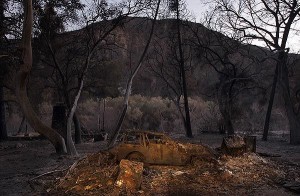The National Weather Service will significantly change to the way forecasters issue red-flag fire warnings, which could mean fewer such alerts for fire-prone areas from Santa Barbara to San Diego.
The changes were made after officials determined that the current red-flag protocols were not always the most accurate precursors to major fires.
For example, the National Weather Service office in San Diego issued warnings during period of low humidity — prompting fire departments to marshal resources — even though officials believe a large wildfire is unlikely there without strong winds.
By contrast, large fires in Los Angeles County can start without high winds, pointing up another vulnerability. That was the case with last year’s Station fire, which was sparked during a period of high temperatures but light winds.
The new red-flag warning system is meant to be more selective and to take into account local geography and terrain as well as wind conditions and humidity levels. San Diego County, which is highly vulnerable during strong winds, will have different criteria than Los Angeles County’s foothills and mountains.
Weather experts found that there are a lot more ways for explosive wildfires to happen in the L.A. area than in Orange to San Diego counties.
“We hope to reduce warnings for conditions we learned don’t produce large, damaging fires,” said Mark Jackson, head meteorologist for the National Weather Service in Oxnard.
The changes have major implications not just for fire departments, which often rely on the warnings to mobilize resources, but also for residents in some hillside areas, who are restricted from street parking during red-flag alerts.
![53348655[1]](http://corbamtb.com/news/wp-content/uploads/2010/04/533486551-300x256.gif)
The Weather Service in San Diego has enacted the new red-flag warning criteria; Oxnard is expecting to apply them as soon as the fire season begins in earnest, possibly as early as June.
The warnings are not predictions of fires but rather of the kind of conditions that are ripe for large-scale blazes.
Weather experts regularly consult with fire officials about these conditions and about the need to tweak the criteria for determining whether red-flag warnings need to be issued.
More than a year ago, fire officials urged the Weather Service to reexamine protocols for issuing the alerts.
Both in San Diego and Oxnard, weather experts conducted historical studies of the conditions that provoked and fanned large, out-of-control fires. The differences were stark from county to county.
“California has so many microclimates. It’s not a one-size-fits-all,” said Daniel Berlant, a spokesman for the California Department of Forestry and Fire Protection, which determines firefighter staffing in part based on the red-flag warnings.
Although typically drier, San Diego County has less steep terrain and sparser vegetation than L.A. County. In part because of this, the counties farther south tend to experience conditions primed for behemoth wildfires only when there are strong winds. That was the case with the deadly Santa Ana-whipped Cedar fire of 2003, which began in central San Diego County. But weather experts there said that for years, they issued warnings based on extremely low relative humidity alone.
The new criteria call for the San Diego’s Weather Service to issue red-flag warnings generally only when extremely low humidity is accompanied by winds of at least 25 mph.
“We found very few cases of large fires” when the only weather factor was low relative humidity, said Jim Purpura, head meteorologist of the National Weather Service in San Diego.
Counties farther north, including L.A. and Santa Barbara, tend to have more mountainous terrain, thicker forests and denser vegetation. When the humidity drops low enough, these conditions can lead to large fires even without vigorous winds.
That was the case with the Station fire, which last year burned more than 160,000 acres in the San Gabriel Mountains.
“The winds were mostly calm. For the most part, that was not a wind event,” said Frank Vidales, an assistant chief for the L.A. County Fire Department’s forestry division. “But it was very hot and very dry.”
In the past, criteria for calling a red-flag warning for Los Angeles County and some other areas included relative humidity of 15% or less and winds of at least 25 mph. Under new standards, those criteria can also be met with winds as low as 15 mph, as long as the humidity dips below 10%, Jackson said.
He pointed out that based strictly on those guidelines, the Station fire may not have been preceded by a red-flag warning because the winds were so weak. But Jackson said that is why forecaster discretion will remain a key part of making the ultimate call.
Jackson said that if the relative humidity is above 15% but the winds are very strong, an alert could still be issued.
“Conversely, if the forecaster feels there’s an extremely dry fuel situation, and that we’re very volatile, they can still issue that red-flag warning without winds,” he said.



![53348655[1]](http://corbamtb.com/news/wp-content/uploads/2010/04/533486551-300x256.gif)
![bilde[1]](http://corbamtb.com/news/wp-content/uploads/2010/03/bilde1-300x181.jpg)

